Financial Analysis Report: Nestle and Almarai Comparison, Spring 2020
VerifiedAdded on 2022/08/10
|13
|3713
|331
Report
AI Summary
This report provides a comprehensive financial analysis of Nestle and Almarai, two major players in the food and beverage industry. It begins with an introduction to financial analysis and its importance in evaluating businesses, followed by company overviews of Nestle and Almarai. The report then delves into external analysis using PESTLE and Porter's Five Forces frameworks to assess the industry's political, economic, social, technological, competitive, and market dynamics. A detailed financial analysis is conducted, focusing on liquidity, profitability, and solvency ratios to evaluate each company's financial health and performance. The analysis includes a comparison of key financial metrics, such as current ratio, quick ratio, return on equity, net profit margin, and debt-equity ratio. The report concludes with a summary of findings, highlighting the strengths and weaknesses of both companies and providing recommendations for management and investors. The report uses data from 2017 to 2019 and also discusses the impact of external factors, such as government investment and changing consumer preferences, on the companies' performance. This analysis aims to provide a clear understanding of the financial positions of Nestle and Almarai, offering valuable insights for stakeholders.

FINANCE AND ACCOUNTING
0
Finance and Accounting
0
Finance and Accounting
Paraphrase This Document
Need a fresh take? Get an instant paraphrase of this document with our AI Paraphraser
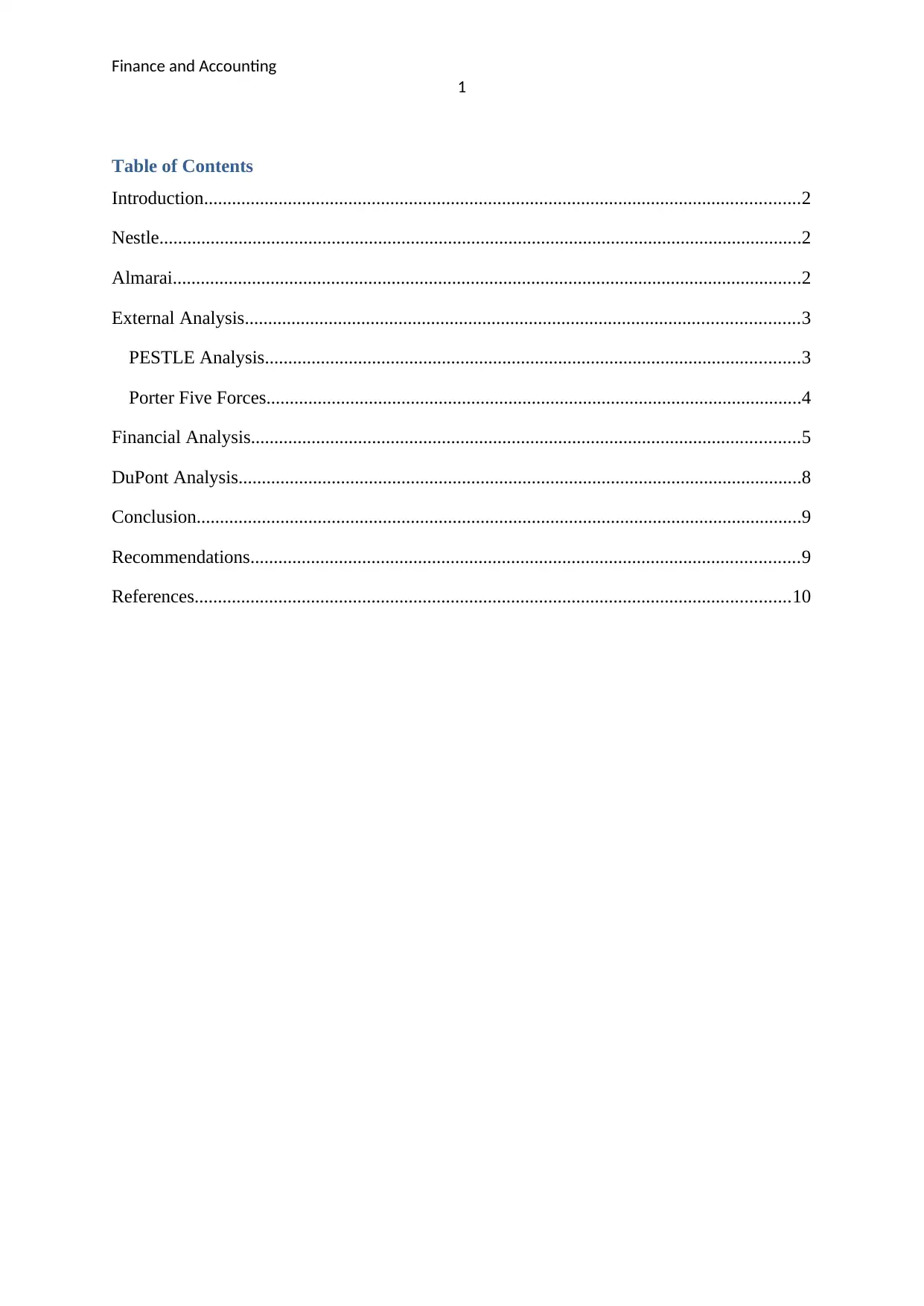
Finance and Accounting
1
Table of Contents
Introduction................................................................................................................................2
Nestle..........................................................................................................................................2
Almarai.......................................................................................................................................2
External Analysis.......................................................................................................................3
PESTLE Analysis...................................................................................................................3
Porter Five Forces...................................................................................................................4
Financial Analysis......................................................................................................................5
DuPont Analysis.........................................................................................................................8
Conclusion..................................................................................................................................9
Recommendations......................................................................................................................9
References................................................................................................................................10
1
Table of Contents
Introduction................................................................................................................................2
Nestle..........................................................................................................................................2
Almarai.......................................................................................................................................2
External Analysis.......................................................................................................................3
PESTLE Analysis...................................................................................................................3
Porter Five Forces...................................................................................................................4
Financial Analysis......................................................................................................................5
DuPont Analysis.........................................................................................................................8
Conclusion..................................................................................................................................9
Recommendations......................................................................................................................9
References................................................................................................................................10

Finance and Accounting
2
Introduction
Financial analysis is considered as the process of evaluating projects, businesses,
budgets and other financial transactions with the motive of knowing their suitability and long
term performance (Schroeder, Clark & Cathey,2019). Mainly financial analysis is done to
know whether an entity is solvent, stable, liquid and profitable for investors (Robinson,2020).
This report helps to understand the concept of financial analysis and tools used to analyze the
position of companies. The financial analysis of Almarai is done and comparison is done
with one of the leading players in the industry that is Nestle. In the below sections, some of
the tools are used such as pestle analysis, porter five forces, and ratio analysis in order to
know the market position and financial position of both companies from the perspective of
creditors and investors. At last, recommendations are given for management regarding value
creation and to investors about the company that gives a good return in the near future.
Nestle
Nestle is an organized business as it covers three geographic zones and many
businesses on a global platform (Yahoo Finance,2019). Nestle manufactures and distributes
beverage and food products in some of the categories that are liquid and powdered beverages,
milk products and water and ice cream, cooking aids and instant dishes and pet care and
confectionary items. Nestle Group has manufacturing units in 85 countries and distributes its
products across 190 countries with employee strength of 308,000 people (Nestle,2020).
In the region, the sales of Nestle products rose by 2.3% in 2019 and registered growth
of 2.8%. Further, the company sales mainly rise in the organic food segment due to the shift
of people towards the consumption of organic food and changing lifestyles (Djarum, Kee,
Azmin & pandit,2019). Some of the main products that are growing and capturing the market
are wafer biscuits, caramel chocolate, chilled and cereals. Nestle has a huge market presence
across the world with a diversified product portfolio as the company offers many brands in
each of its segments. Nestle is planning to triple its sales by 2020 in the Middle East region
(Galalae & George,2018).
2
Introduction
Financial analysis is considered as the process of evaluating projects, businesses,
budgets and other financial transactions with the motive of knowing their suitability and long
term performance (Schroeder, Clark & Cathey,2019). Mainly financial analysis is done to
know whether an entity is solvent, stable, liquid and profitable for investors (Robinson,2020).
This report helps to understand the concept of financial analysis and tools used to analyze the
position of companies. The financial analysis of Almarai is done and comparison is done
with one of the leading players in the industry that is Nestle. In the below sections, some of
the tools are used such as pestle analysis, porter five forces, and ratio analysis in order to
know the market position and financial position of both companies from the perspective of
creditors and investors. At last, recommendations are given for management regarding value
creation and to investors about the company that gives a good return in the near future.
Nestle
Nestle is an organized business as it covers three geographic zones and many
businesses on a global platform (Yahoo Finance,2019). Nestle manufactures and distributes
beverage and food products in some of the categories that are liquid and powdered beverages,
milk products and water and ice cream, cooking aids and instant dishes and pet care and
confectionary items. Nestle Group has manufacturing units in 85 countries and distributes its
products across 190 countries with employee strength of 308,000 people (Nestle,2020).
In the region, the sales of Nestle products rose by 2.3% in 2019 and registered growth
of 2.8%. Further, the company sales mainly rise in the organic food segment due to the shift
of people towards the consumption of organic food and changing lifestyles (Djarum, Kee,
Azmin & pandit,2019). Some of the main products that are growing and capturing the market
are wafer biscuits, caramel chocolate, chilled and cereals. Nestle has a huge market presence
across the world with a diversified product portfolio as the company offers many brands in
each of its segments. Nestle is planning to triple its sales by 2020 in the Middle East region
(Galalae & George,2018).
⊘ This is a preview!⊘
Do you want full access?
Subscribe today to unlock all pages.

Trusted by 1+ million students worldwide

Finance and Accounting
3
Almarai
Almarai Company based in Saudi Arabia and was founded in 1977 by Irish Agri
Pioneers and Paddy McGuckian (Fabbe, Kindred & AlAmin,2018). .The company mainly
operates in the segment of beverage and food manufacturing and distribution. Almarai is
amongst the leading FMCG brand in North Africa and the Middle East region (Singh and
Hagahmoodi,2017). The company is providing healthy and nutritious products to consumers
of all ages from the last 40 years with the principle of “Quality you can trust” (Fabbe,
Kindred & AlAmin,2018).
Further, Almarai offers a diversified product portfolio to its customers that include
bakery, juices, infant formula, and poultry. As of 31 December 2018, the paid-up share
capital of the company was SAR 10.0 billion and tradable share at the end amounted to 216
million that represented 21.7% of the capital of Almarai with that market capitalization was
SAR 48 billion (Fabbe, Kindred & AlAmin,2018). The net profits of the company dropped in
2019 by 10% and stood at SAR 1.81 billion and market capitalization in December 2019 was
47 billion Almarai has a strong workforce and the company focuses on retaining, attracting
and developing talent by investing in people. At present, the company has 42,971 employees
from its 8,766 are Saudi employees and 750 are female employees (Fabbe, Amin, Cekin &
Kindred,2018).
External Analysis
PESTLE Analysis
Political: The political factors that are affecting the business in the Gulf region or in the
Middle East are; increasing investment by the government in the food and beverage industry
as this segment in Saudi Arabia valued at $45 billion (Muazu, Blaisi, Naji & Alquanthny,
2019). The government provides import subsidies to companies in order to increase the
market in 2020 (Alsukait, Bleich, Wilde & Folta,2020). Hence this is an opportunity for
companies that are operating in the food and beverage industry in Saudi Arabia (Hassen &
ElBilali,2019).
Economic: Economic factors include economic growth, consumption and spending pattern of
people and income level. Saudi Arabia has the largest population in the GCC that is 29
million residents and a growth rate of 3.3 percent Arabia (Hassen & ElBilali,2019). On an
average $70 billion was spent by people on food and beverage consumption in 2019 Arabia
3
Almarai
Almarai Company based in Saudi Arabia and was founded in 1977 by Irish Agri
Pioneers and Paddy McGuckian (Fabbe, Kindred & AlAmin,2018). .The company mainly
operates in the segment of beverage and food manufacturing and distribution. Almarai is
amongst the leading FMCG brand in North Africa and the Middle East region (Singh and
Hagahmoodi,2017). The company is providing healthy and nutritious products to consumers
of all ages from the last 40 years with the principle of “Quality you can trust” (Fabbe,
Kindred & AlAmin,2018).
Further, Almarai offers a diversified product portfolio to its customers that include
bakery, juices, infant formula, and poultry. As of 31 December 2018, the paid-up share
capital of the company was SAR 10.0 billion and tradable share at the end amounted to 216
million that represented 21.7% of the capital of Almarai with that market capitalization was
SAR 48 billion (Fabbe, Kindred & AlAmin,2018). The net profits of the company dropped in
2019 by 10% and stood at SAR 1.81 billion and market capitalization in December 2019 was
47 billion Almarai has a strong workforce and the company focuses on retaining, attracting
and developing talent by investing in people. At present, the company has 42,971 employees
from its 8,766 are Saudi employees and 750 are female employees (Fabbe, Amin, Cekin &
Kindred,2018).
External Analysis
PESTLE Analysis
Political: The political factors that are affecting the business in the Gulf region or in the
Middle East are; increasing investment by the government in the food and beverage industry
as this segment in Saudi Arabia valued at $45 billion (Muazu, Blaisi, Naji & Alquanthny,
2019). The government provides import subsidies to companies in order to increase the
market in 2020 (Alsukait, Bleich, Wilde & Folta,2020). Hence this is an opportunity for
companies that are operating in the food and beverage industry in Saudi Arabia (Hassen &
ElBilali,2019).
Economic: Economic factors include economic growth, consumption and spending pattern of
people and income level. Saudi Arabia has the largest population in the GCC that is 29
million residents and a growth rate of 3.3 percent Arabia (Hassen & ElBilali,2019). On an
average $70 billion was spent by people on food and beverage consumption in 2019 Arabia
Paraphrase This Document
Need a fresh take? Get an instant paraphrase of this document with our AI Paraphraser
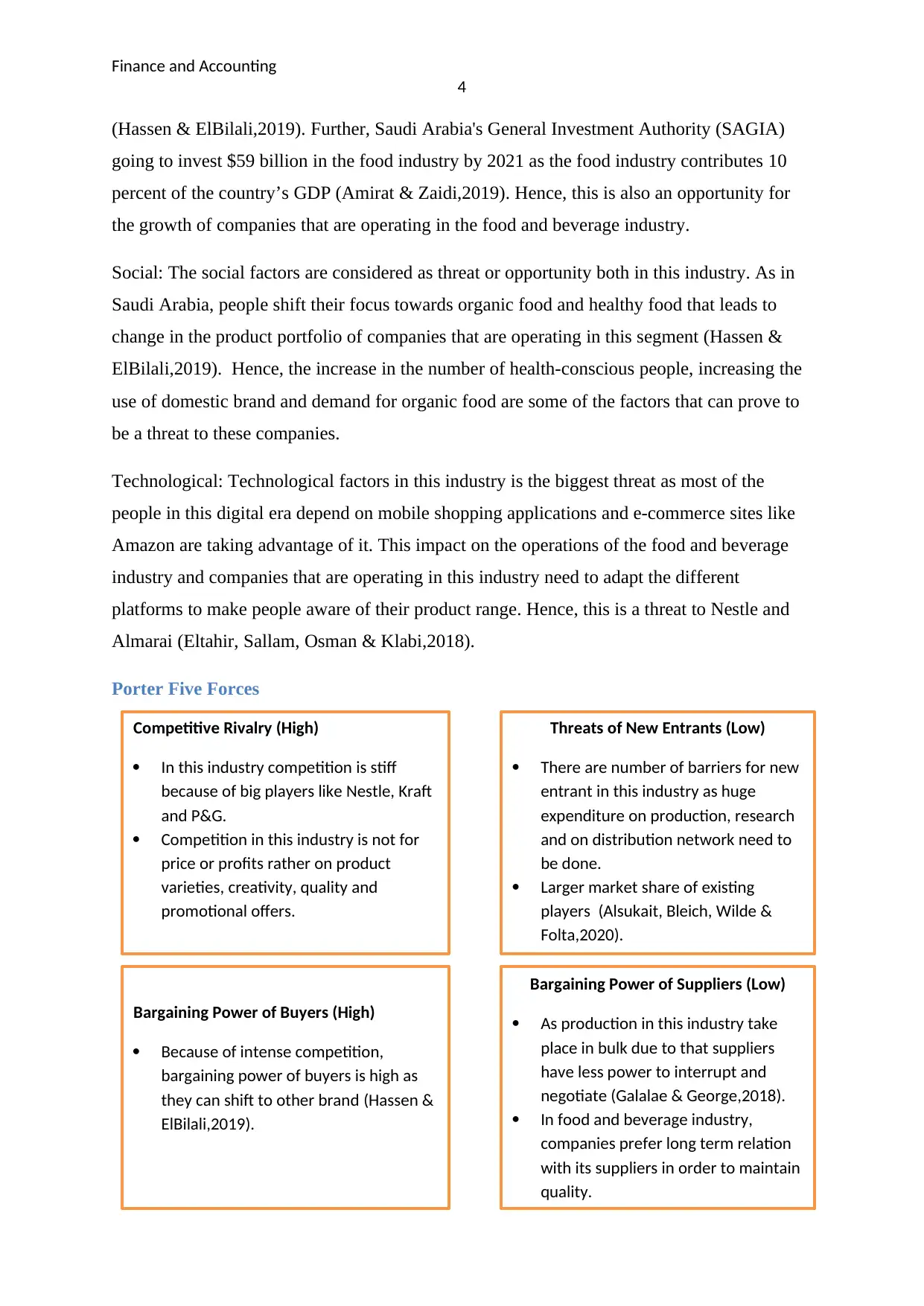
Finance and Accounting
4
(Hassen & ElBilali,2019). Further, Saudi Arabia's General Investment Authority (SAGIA)
going to invest $59 billion in the food industry by 2021 as the food industry contributes 10
percent of the country’s GDP (Amirat & Zaidi,2019). Hence, this is also an opportunity for
the growth of companies that are operating in the food and beverage industry.
Social: The social factors are considered as threat or opportunity both in this industry. As in
Saudi Arabia, people shift their focus towards organic food and healthy food that leads to
change in the product portfolio of companies that are operating in this segment (Hassen &
ElBilali,2019). Hence, the increase in the number of health-conscious people, increasing the
use of domestic brand and demand for organic food are some of the factors that can prove to
be a threat to these companies.
Technological: Technological factors in this industry is the biggest threat as most of the
people in this digital era depend on mobile shopping applications and e-commerce sites like
Amazon are taking advantage of it. This impact on the operations of the food and beverage
industry and companies that are operating in this industry need to adapt the different
platforms to make people aware of their product range. Hence, this is a threat to Nestle and
Almarai (Eltahir, Sallam, Osman & Klabi,2018).
Porter Five Forces
Competitive Rivalry (High)
In this industry competition is stiff
because of big players like Nestle, Kraft
and P&G.
Competition in this industry is not for
price or profits rather on product
varieties, creativity, quality and
promotional offers.
Bargaining Power of Buyers (High)
Because of intense competition,
bargaining power of buyers is high as
they can shift to other brand (Hassen &
ElBilali,2019).
Bargaining Power of Suppliers (Low)
As production in this industry take
place in bulk due to that suppliers
have less power to interrupt and
negotiate (Galalae & George,2018).
In food and beverage industry,
companies prefer long term relation
with its suppliers in order to maintain
quality.
Threats of New Entrants (Low)
There are number of barriers for new
entrant in this industry as huge
expenditure on production, research
and on distribution network need to
be done.
Larger market share of existing
players (Alsukait, Bleich, Wilde &
Folta,2020).
4
(Hassen & ElBilali,2019). Further, Saudi Arabia's General Investment Authority (SAGIA)
going to invest $59 billion in the food industry by 2021 as the food industry contributes 10
percent of the country’s GDP (Amirat & Zaidi,2019). Hence, this is also an opportunity for
the growth of companies that are operating in the food and beverage industry.
Social: The social factors are considered as threat or opportunity both in this industry. As in
Saudi Arabia, people shift their focus towards organic food and healthy food that leads to
change in the product portfolio of companies that are operating in this segment (Hassen &
ElBilali,2019). Hence, the increase in the number of health-conscious people, increasing the
use of domestic brand and demand for organic food are some of the factors that can prove to
be a threat to these companies.
Technological: Technological factors in this industry is the biggest threat as most of the
people in this digital era depend on mobile shopping applications and e-commerce sites like
Amazon are taking advantage of it. This impact on the operations of the food and beverage
industry and companies that are operating in this industry need to adapt the different
platforms to make people aware of their product range. Hence, this is a threat to Nestle and
Almarai (Eltahir, Sallam, Osman & Klabi,2018).
Porter Five Forces
Competitive Rivalry (High)
In this industry competition is stiff
because of big players like Nestle, Kraft
and P&G.
Competition in this industry is not for
price or profits rather on product
varieties, creativity, quality and
promotional offers.
Bargaining Power of Buyers (High)
Because of intense competition,
bargaining power of buyers is high as
they can shift to other brand (Hassen &
ElBilali,2019).
Bargaining Power of Suppliers (Low)
As production in this industry take
place in bulk due to that suppliers
have less power to interrupt and
negotiate (Galalae & George,2018).
In food and beverage industry,
companies prefer long term relation
with its suppliers in order to maintain
quality.
Threats of New Entrants (Low)
There are number of barriers for new
entrant in this industry as huge
expenditure on production, research
and on distribution network need to
be done.
Larger market share of existing
players (Alsukait, Bleich, Wilde &
Folta,2020).
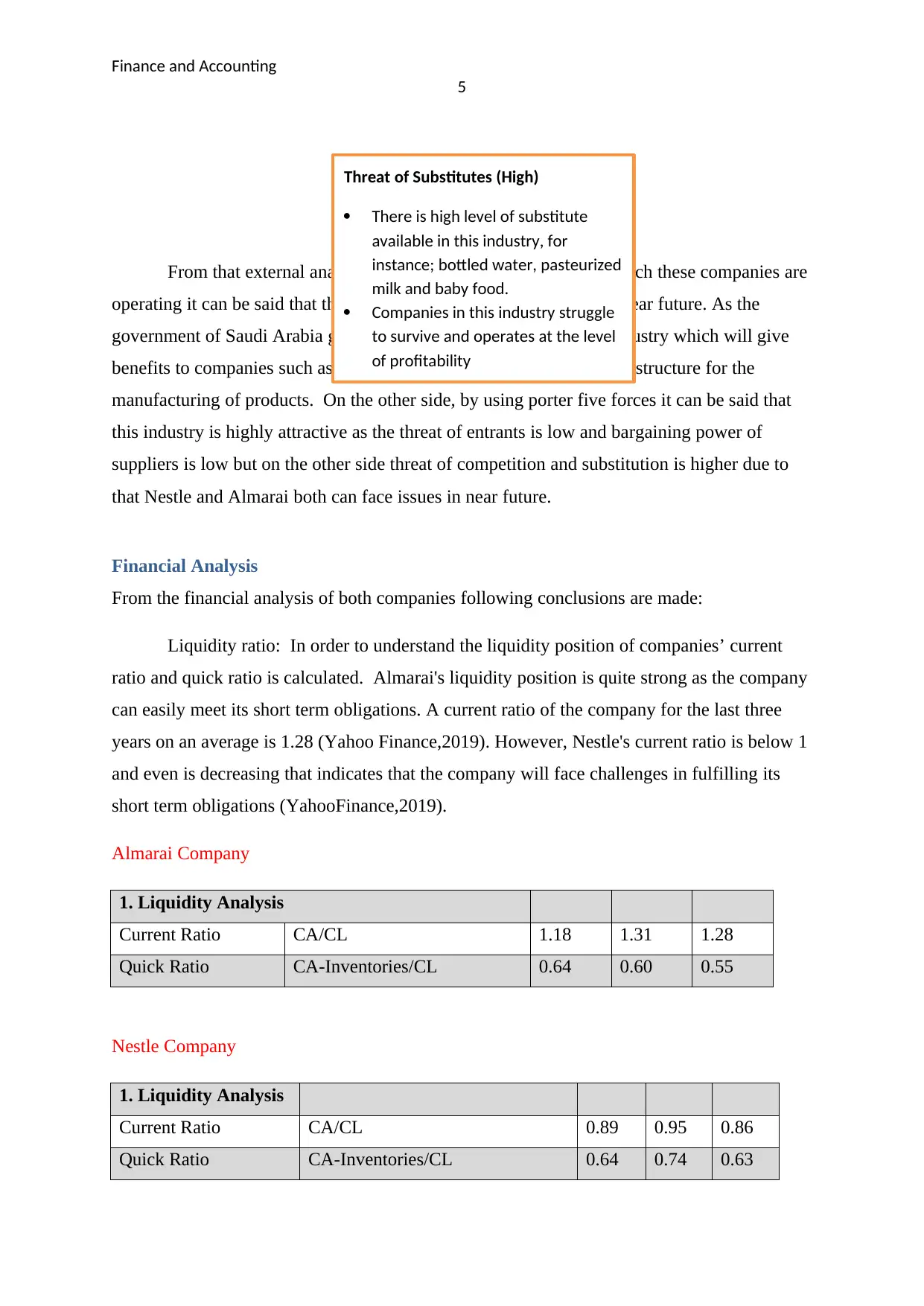
Finance and Accounting
5
From that external analysis of the business environment in which these companies are
operating it can be said that there are positive signs of growth in the near future. As the
government of Saudi Arabia going to invest a huge amount in this industry which will give
benefits to companies such as subsidies on import and developed infrastructure for the
manufacturing of products. On the other side, by using porter five forces it can be said that
this industry is highly attractive as the threat of entrants is low and bargaining power of
suppliers is low but on the other side threat of competition and substitution is higher due to
that Nestle and Almarai both can face issues in near future.
Financial Analysis
From the financial analysis of both companies following conclusions are made:
Liquidity ratio: In order to understand the liquidity position of companies’ current
ratio and quick ratio is calculated. Almarai's liquidity position is quite strong as the company
can easily meet its short term obligations. A current ratio of the company for the last three
years on an average is 1.28 (Yahoo Finance,2019). However, Nestle's current ratio is below 1
and even is decreasing that indicates that the company will face challenges in fulfilling its
short term obligations (YahooFinance,2019).
Almarai Company
1. Liquidity Analysis
Current Ratio CA/CL 1.18 1.31 1.28
Quick Ratio CA-Inventories/CL 0.64 0.60 0.55
Nestle Company
1. Liquidity Analysis
Current Ratio CA/CL 0.89 0.95 0.86
Quick Ratio CA-Inventories/CL 0.64 0.74 0.63
Threat of Substitutes (High)
There is high level of substitute
available in this industry, for
instance; bottled water, pasteurized
milk and baby food.
Companies in this industry struggle
to survive and operates at the level
of profitability
5
From that external analysis of the business environment in which these companies are
operating it can be said that there are positive signs of growth in the near future. As the
government of Saudi Arabia going to invest a huge amount in this industry which will give
benefits to companies such as subsidies on import and developed infrastructure for the
manufacturing of products. On the other side, by using porter five forces it can be said that
this industry is highly attractive as the threat of entrants is low and bargaining power of
suppliers is low but on the other side threat of competition and substitution is higher due to
that Nestle and Almarai both can face issues in near future.
Financial Analysis
From the financial analysis of both companies following conclusions are made:
Liquidity ratio: In order to understand the liquidity position of companies’ current
ratio and quick ratio is calculated. Almarai's liquidity position is quite strong as the company
can easily meet its short term obligations. A current ratio of the company for the last three
years on an average is 1.28 (Yahoo Finance,2019). However, Nestle's current ratio is below 1
and even is decreasing that indicates that the company will face challenges in fulfilling its
short term obligations (YahooFinance,2019).
Almarai Company
1. Liquidity Analysis
Current Ratio CA/CL 1.18 1.31 1.28
Quick Ratio CA-Inventories/CL 0.64 0.60 0.55
Nestle Company
1. Liquidity Analysis
Current Ratio CA/CL 0.89 0.95 0.86
Quick Ratio CA-Inventories/CL 0.64 0.74 0.63
Threat of Substitutes (High)
There is high level of substitute
available in this industry, for
instance; bottled water, pasteurized
milk and baby food.
Companies in this industry struggle
to survive and operates at the level
of profitability
⊘ This is a preview!⊘
Do you want full access?
Subscribe today to unlock all pages.

Trusted by 1+ million students worldwide

Finance and Accounting
6
Profitability ratio: From the profitability analysis of both companies it is identified
that as per industry standard Almarai Company profits are good as in 2017 the company
showed 14% returns and in 2018 16%. On average, Almarai profits are 15% in this industry.
In comparison to Nestle, earlier the company had 8% profits but the profitability status of
Nestle has improved and in 2019 the company showed 14% profits. But add on advantage for
Nestle is its increasing return on equity because of its increasing profits and sales
shareholders of the company is getting higher return (Yahoo Finance,2019). ROE of Almarai
is decreasing because of the focus of the company in investing activities such as expansion
and R&D and diversifying its product portfolio. Almarai is raising funds through issuing
more shares as its equity in 2018 was $14,516 and in 2019 was $15,259. The company raised
$743 million from equity within a year (Investing.com,2019). In a nutshell, the profitability
of Nestle is quite strong and the company is growing.
Almarai Company
2. Profitability ratio
Return on Equity
Net profit/Shareholders
Equity 13% 15% 12%
Net Profit Margin Net Profits/Sales 14% 16% 13%
Nestle Company
2. Profitability ratio
Return on Equity Net profit/Shareholders Equity 12% 18% 24%
Net Profit Margin Net Profits/Sales 8% 11% 14%
Solvency ratio: After analysis of liquidity position and profitability position of
companies its time to analyze the solvency condition. Analyzing solvency of the company is
important in order to know the cash flows of the company with that it can be identified that
the company is able to meet its long term liabilities and to survive in the market for the long
run or not (Fazzini,2018). From the debt-equity ratio, it is identified that lower the ratio
better the financial position of the company as from comparison it is seen that the debt ratio
6
Profitability ratio: From the profitability analysis of both companies it is identified
that as per industry standard Almarai Company profits are good as in 2017 the company
showed 14% returns and in 2018 16%. On average, Almarai profits are 15% in this industry.
In comparison to Nestle, earlier the company had 8% profits but the profitability status of
Nestle has improved and in 2019 the company showed 14% profits. But add on advantage for
Nestle is its increasing return on equity because of its increasing profits and sales
shareholders of the company is getting higher return (Yahoo Finance,2019). ROE of Almarai
is decreasing because of the focus of the company in investing activities such as expansion
and R&D and diversifying its product portfolio. Almarai is raising funds through issuing
more shares as its equity in 2018 was $14,516 and in 2019 was $15,259. The company raised
$743 million from equity within a year (Investing.com,2019). In a nutshell, the profitability
of Nestle is quite strong and the company is growing.
Almarai Company
2. Profitability ratio
Return on Equity
Net profit/Shareholders
Equity 13% 15% 12%
Net Profit Margin Net Profits/Sales 14% 16% 13%
Nestle Company
2. Profitability ratio
Return on Equity Net profit/Shareholders Equity 12% 18% 24%
Net Profit Margin Net Profits/Sales 8% 11% 14%
Solvency ratio: After analysis of liquidity position and profitability position of
companies its time to analyze the solvency condition. Analyzing solvency of the company is
important in order to know the cash flows of the company with that it can be identified that
the company is able to meet its long term liabilities and to survive in the market for the long
run or not (Fazzini,2018). From the debt-equity ratio, it is identified that lower the ratio
better the financial position of the company as from comparison it is seen that the debt ratio
Paraphrase This Document
Need a fresh take? Get an instant paraphrase of this document with our AI Paraphraser
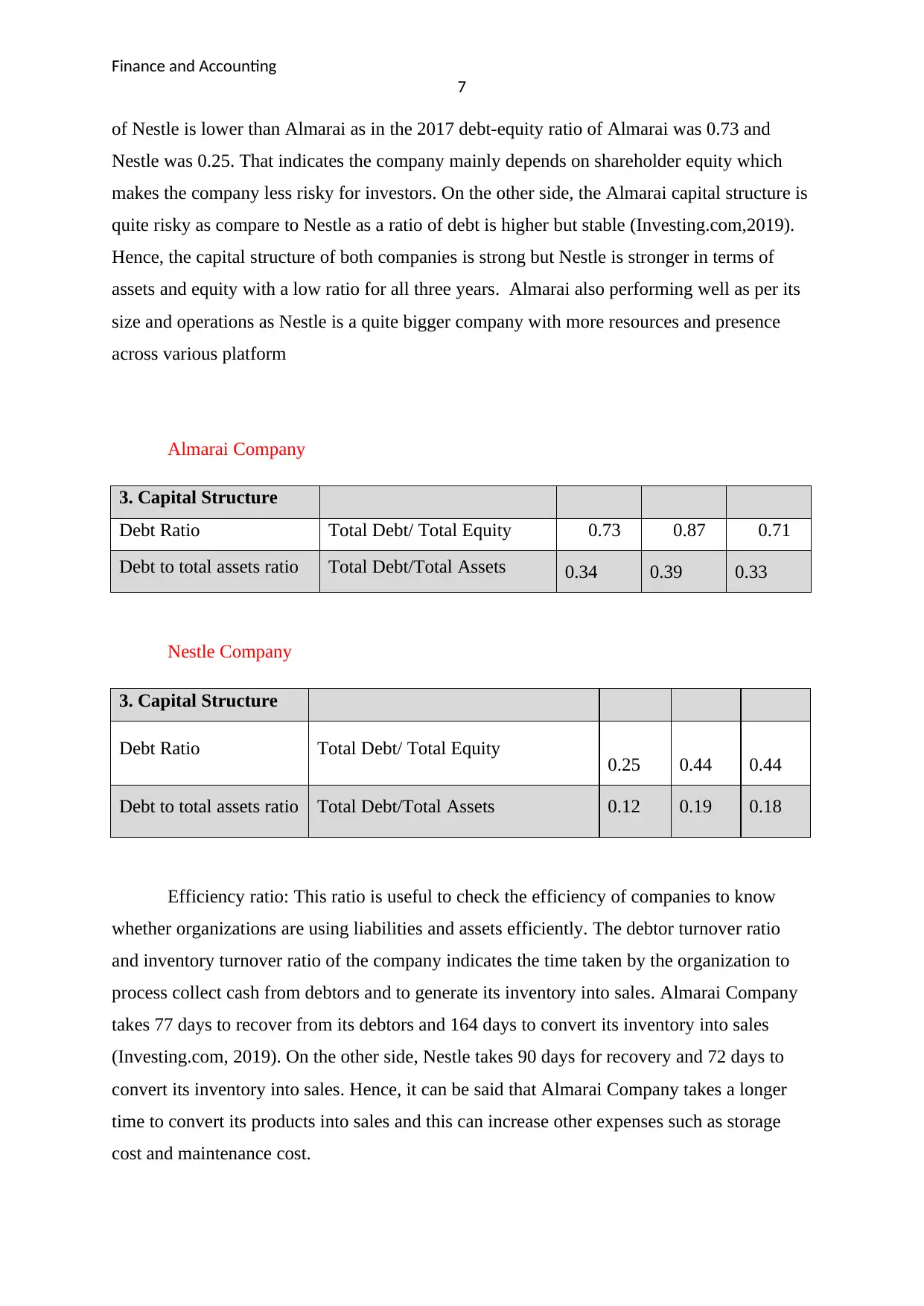
Finance and Accounting
7
of Nestle is lower than Almarai as in the 2017 debt-equity ratio of Almarai was 0.73 and
Nestle was 0.25. That indicates the company mainly depends on shareholder equity which
makes the company less risky for investors. On the other side, the Almarai capital structure is
quite risky as compare to Nestle as a ratio of debt is higher but stable (Investing.com,2019).
Hence, the capital structure of both companies is strong but Nestle is stronger in terms of
assets and equity with a low ratio for all three years. Almarai also performing well as per its
size and operations as Nestle is a quite bigger company with more resources and presence
across various platform
Almarai Company
3. Capital Structure
Debt Ratio Total Debt/ Total Equity 0.73 0.87 0.71
Debt to total assets ratio Total Debt/Total Assets 0.34 0.39 0.33
Nestle Company
3. Capital Structure
Debt Ratio Total Debt/ Total Equity 0.25 0.44 0.44
Debt to total assets ratio Total Debt/Total Assets 0.12 0.19 0.18
Efficiency ratio: This ratio is useful to check the efficiency of companies to know
whether organizations are using liabilities and assets efficiently. The debtor turnover ratio
and inventory turnover ratio of the company indicates the time taken by the organization to
process collect cash from debtors and to generate its inventory into sales. Almarai Company
takes 77 days to recover from its debtors and 164 days to convert its inventory into sales
(Investing.com, 2019). On the other side, Nestle takes 90 days for recovery and 72 days to
convert its inventory into sales. Hence, it can be said that Almarai Company takes a longer
time to convert its products into sales and this can increase other expenses such as storage
cost and maintenance cost.
7
of Nestle is lower than Almarai as in the 2017 debt-equity ratio of Almarai was 0.73 and
Nestle was 0.25. That indicates the company mainly depends on shareholder equity which
makes the company less risky for investors. On the other side, the Almarai capital structure is
quite risky as compare to Nestle as a ratio of debt is higher but stable (Investing.com,2019).
Hence, the capital structure of both companies is strong but Nestle is stronger in terms of
assets and equity with a low ratio for all three years. Almarai also performing well as per its
size and operations as Nestle is a quite bigger company with more resources and presence
across various platform
Almarai Company
3. Capital Structure
Debt Ratio Total Debt/ Total Equity 0.73 0.87 0.71
Debt to total assets ratio Total Debt/Total Assets 0.34 0.39 0.33
Nestle Company
3. Capital Structure
Debt Ratio Total Debt/ Total Equity 0.25 0.44 0.44
Debt to total assets ratio Total Debt/Total Assets 0.12 0.19 0.18
Efficiency ratio: This ratio is useful to check the efficiency of companies to know
whether organizations are using liabilities and assets efficiently. The debtor turnover ratio
and inventory turnover ratio of the company indicates the time taken by the organization to
process collect cash from debtors and to generate its inventory into sales. Almarai Company
takes 77 days to recover from its debtors and 164 days to convert its inventory into sales
(Investing.com, 2019). On the other side, Nestle takes 90 days for recovery and 72 days to
convert its inventory into sales. Hence, it can be said that Almarai Company takes a longer
time to convert its products into sales and this can increase other expenses such as storage
cost and maintenance cost.

Finance and Accounting
8
Almarai Company
4. Efficiency Ratio
Debtor turnover ratio Average Debtors/ Cost of
sales * 365 71 80 77
Inventory turnover ratio
Average Inventory/Cost of
Sales*365 134 154 164
Nestle Company
4. Efficiency Ratio
Debtor turnover ratio Average Debtors/ Cost of sales *
365 101 93 90
Inventory turnover ratio Average Inventory/Cost of
Sales*365 71 72 72
DuPont Analysis
Du Pont Analysis is a three-step parameter that is used to know business growth and
sustainability. The Almarai Company profit margin of the last three years is higher that
indicates that the company is good from the perspective of investors (Investing.com, 2019).
But on the other side, Nestle's profit margin is improving which is a good indicator for
investors. In 2019 return on equity for Almarai was 12% and for Nestle was 24%. The
Almarai Company was lacking behind because of low-profit margins as compared to Nestle.
In order to increase return on equity, the company needs to focus on increasing its profit
margin. Moreover, the comparison between the two companies is quite difficult because of
their size and scale of operations. But from the view of investors return on equity for both
companies is on an average 18%.
DuPont Analysis
Almarai Company Nestle Company
Items 2017 2018 2019 2017 2018 2019
Net profits 2,007 2,159 1,801 7,538 10,46
8
12,90
4
Sales 13,936 13,723 14,351 89,79 91,43 92,56
8
Almarai Company
4. Efficiency Ratio
Debtor turnover ratio Average Debtors/ Cost of
sales * 365 71 80 77
Inventory turnover ratio
Average Inventory/Cost of
Sales*365 134 154 164
Nestle Company
4. Efficiency Ratio
Debtor turnover ratio Average Debtors/ Cost of sales *
365 101 93 90
Inventory turnover ratio Average Inventory/Cost of
Sales*365 71 72 72
DuPont Analysis
Du Pont Analysis is a three-step parameter that is used to know business growth and
sustainability. The Almarai Company profit margin of the last three years is higher that
indicates that the company is good from the perspective of investors (Investing.com, 2019).
But on the other side, Nestle's profit margin is improving which is a good indicator for
investors. In 2019 return on equity for Almarai was 12% and for Nestle was 24%. The
Almarai Company was lacking behind because of low-profit margins as compared to Nestle.
In order to increase return on equity, the company needs to focus on increasing its profit
margin. Moreover, the comparison between the two companies is quite difficult because of
their size and scale of operations. But from the view of investors return on equity for both
companies is on an average 18%.
DuPont Analysis
Almarai Company Nestle Company
Items 2017 2018 2019 2017 2018 2019
Net profits 2,007 2,159 1,801 7,538 10,46
8
12,90
4
Sales 13,936 13,723 14,351 89,79 91,43 92,56
⊘ This is a preview!⊘
Do you want full access?
Subscribe today to unlock all pages.

Trusted by 1+ million students worldwide
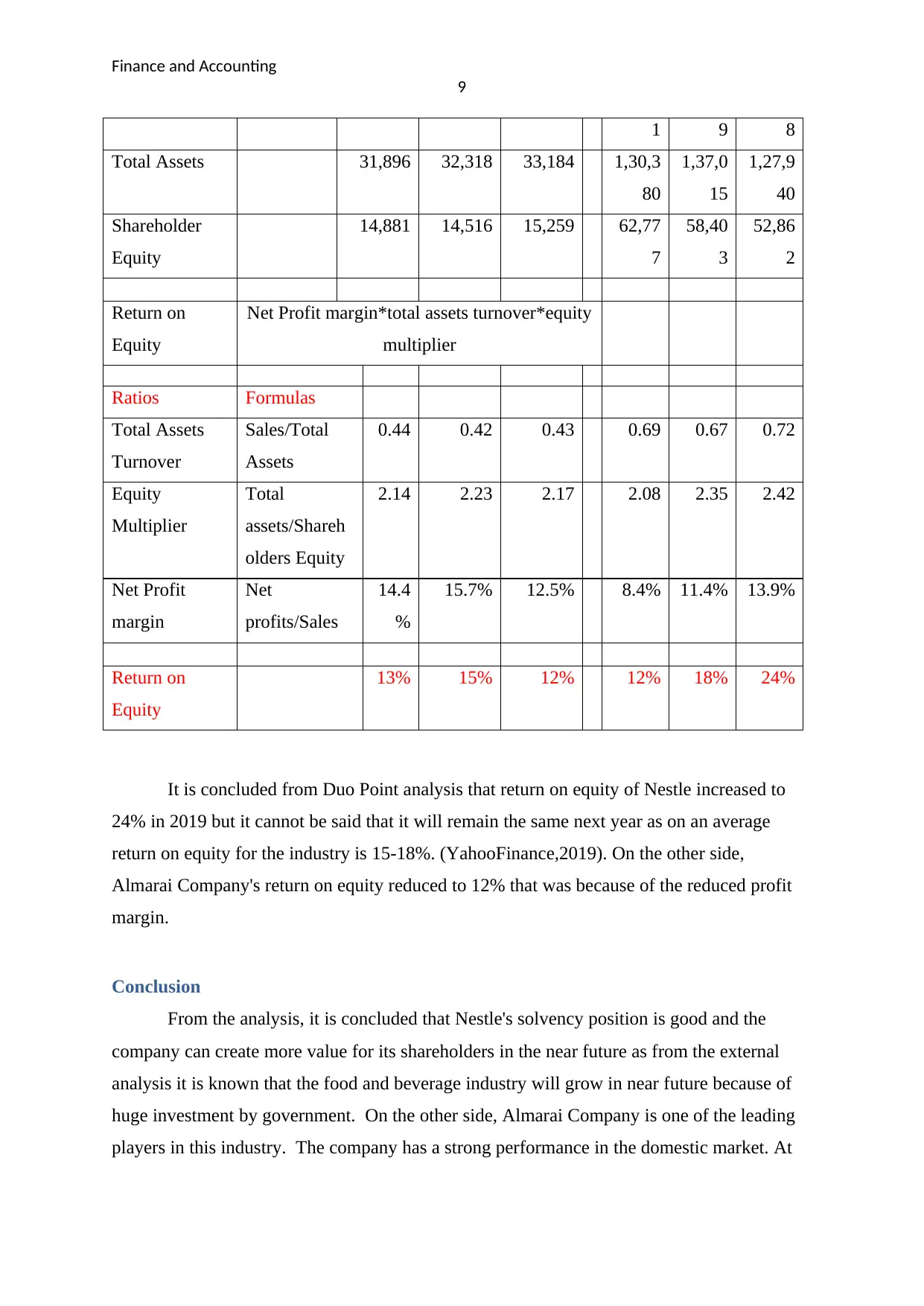
Finance and Accounting
9
1 9 8
Total Assets 31,896 32,318 33,184 1,30,3
80
1,37,0
15
1,27,9
40
Shareholder
Equity
14,881 14,516 15,259 62,77
7
58,40
3
52,86
2
Return on
Equity
Net Profit margin*total assets turnover*equity
multiplier
Ratios Formulas
Total Assets
Turnover
Sales/Total
Assets
0.44 0.42 0.43 0.69 0.67 0.72
Equity
Multiplier
Total
assets/Shareh
olders Equity
2.14 2.23 2.17 2.08 2.35 2.42
Net Profit
margin
Net
profits/Sales
14.4
%
15.7% 12.5% 8.4% 11.4% 13.9%
Return on
Equity
13% 15% 12% 12% 18% 24%
It is concluded from Duo Point analysis that return on equity of Nestle increased to
24% in 2019 but it cannot be said that it will remain the same next year as on an average
return on equity for the industry is 15-18%. (YahooFinance,2019). On the other side,
Almarai Company's return on equity reduced to 12% that was because of the reduced profit
margin.
Conclusion
From the analysis, it is concluded that Nestle's solvency position is good and the
company can create more value for its shareholders in the near future as from the external
analysis it is known that the food and beverage industry will grow in near future because of
huge investment by government. On the other side, Almarai Company is one of the leading
players in this industry. The company has a strong performance in the domestic market. At
9
1 9 8
Total Assets 31,896 32,318 33,184 1,30,3
80
1,37,0
15
1,27,9
40
Shareholder
Equity
14,881 14,516 15,259 62,77
7
58,40
3
52,86
2
Return on
Equity
Net Profit margin*total assets turnover*equity
multiplier
Ratios Formulas
Total Assets
Turnover
Sales/Total
Assets
0.44 0.42 0.43 0.69 0.67 0.72
Equity
Multiplier
Total
assets/Shareh
olders Equity
2.14 2.23 2.17 2.08 2.35 2.42
Net Profit
margin
Net
profits/Sales
14.4
%
15.7% 12.5% 8.4% 11.4% 13.9%
Return on
Equity
13% 15% 12% 12% 18% 24%
It is concluded from Duo Point analysis that return on equity of Nestle increased to
24% in 2019 but it cannot be said that it will remain the same next year as on an average
return on equity for the industry is 15-18%. (YahooFinance,2019). On the other side,
Almarai Company's return on equity reduced to 12% that was because of the reduced profit
margin.
Conclusion
From the analysis, it is concluded that Nestle's solvency position is good and the
company can create more value for its shareholders in the near future as from the external
analysis it is known that the food and beverage industry will grow in near future because of
huge investment by government. On the other side, Almarai Company is one of the leading
players in this industry. The company has a strong performance in the domestic market. At
Paraphrase This Document
Need a fresh take? Get an instant paraphrase of this document with our AI Paraphraser
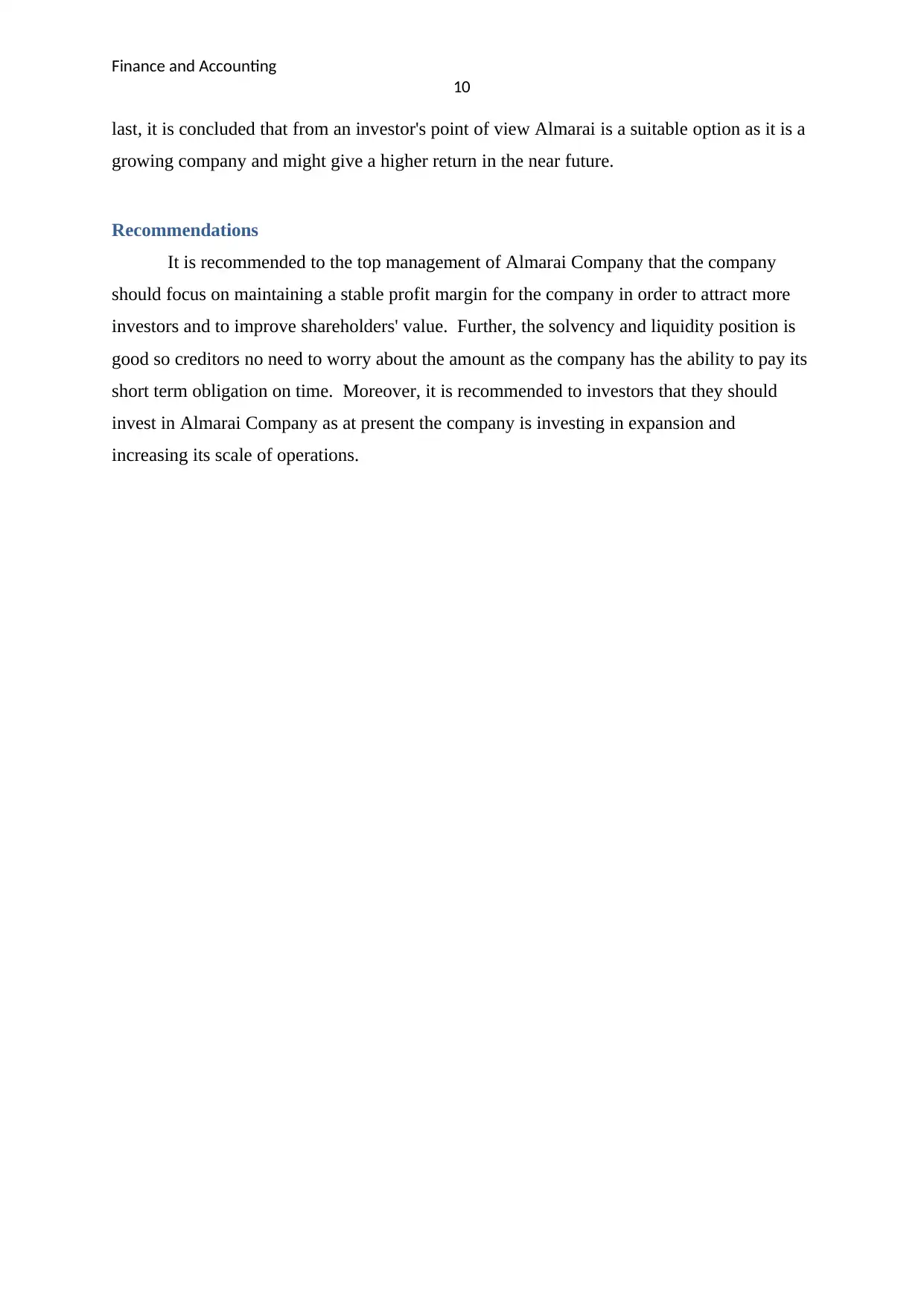
Finance and Accounting
10
last, it is concluded that from an investor's point of view Almarai is a suitable option as it is a
growing company and might give a higher return in the near future.
Recommendations
It is recommended to the top management of Almarai Company that the company
should focus on maintaining a stable profit margin for the company in order to attract more
investors and to improve shareholders' value. Further, the solvency and liquidity position is
good so creditors no need to worry about the amount as the company has the ability to pay its
short term obligation on time. Moreover, it is recommended to investors that they should
invest in Almarai Company as at present the company is investing in expansion and
increasing its scale of operations.
10
last, it is concluded that from an investor's point of view Almarai is a suitable option as it is a
growing company and might give a higher return in the near future.
Recommendations
It is recommended to the top management of Almarai Company that the company
should focus on maintaining a stable profit margin for the company in order to attract more
investors and to improve shareholders' value. Further, the solvency and liquidity position is
good so creditors no need to worry about the amount as the company has the ability to pay its
short term obligation on time. Moreover, it is recommended to investors that they should
invest in Almarai Company as at present the company is investing in expansion and
increasing its scale of operations.
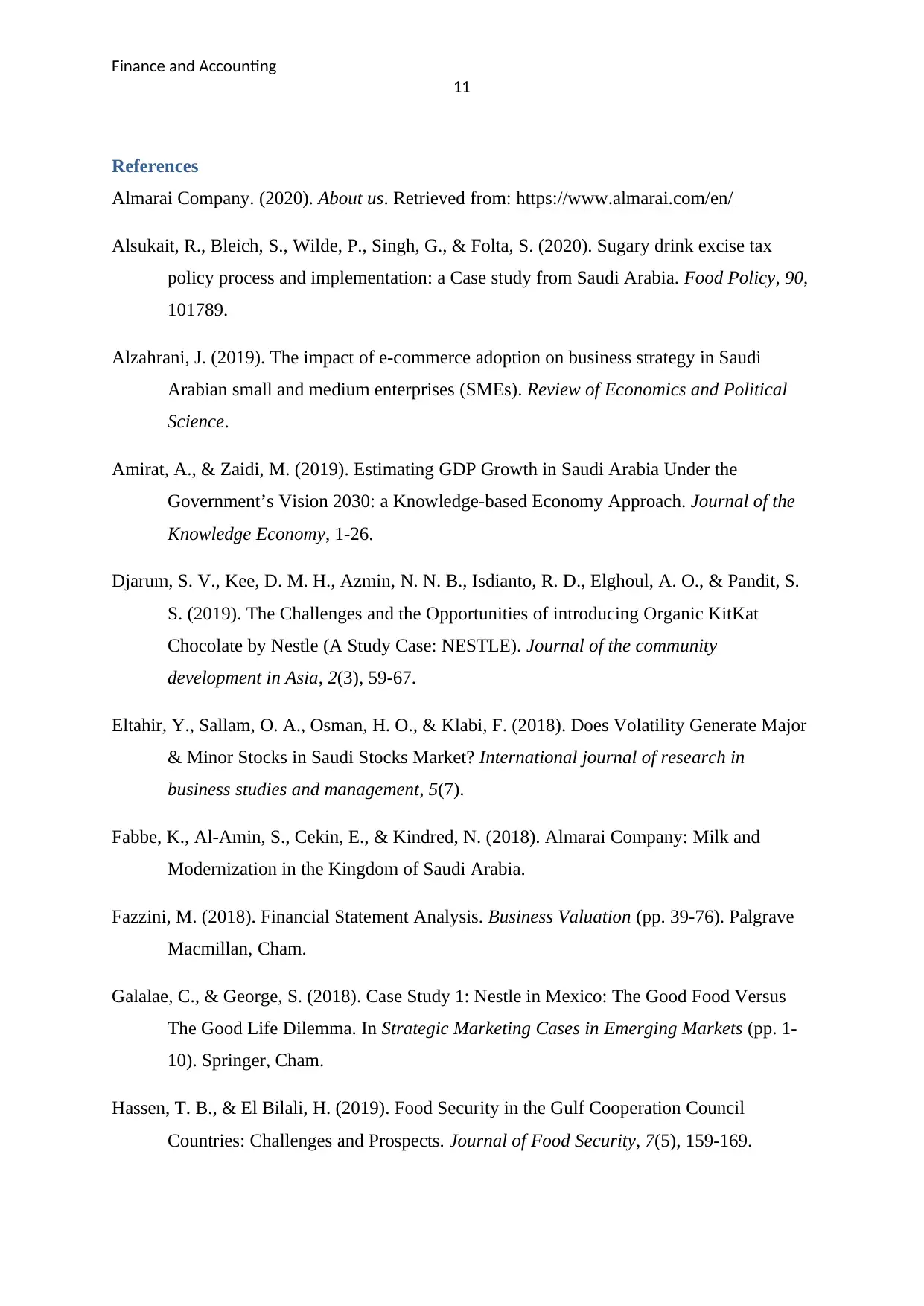
Finance and Accounting
11
References
Almarai Company. (2020). About us. Retrieved from: https://www.almarai.com/en/
Alsukait, R., Bleich, S., Wilde, P., Singh, G., & Folta, S. (2020). Sugary drink excise tax
policy process and implementation: a Case study from Saudi Arabia. Food Policy, 90,
101789.
Alzahrani, J. (2019). The impact of e-commerce adoption on business strategy in Saudi
Arabian small and medium enterprises (SMEs). Review of Economics and Political
Science.
Amirat, A., & Zaidi, M. (2019). Estimating GDP Growth in Saudi Arabia Under the
Government’s Vision 2030: a Knowledge-based Economy Approach. Journal of the
Knowledge Economy, 1-26.
Djarum, S. V., Kee, D. M. H., Azmin, N. N. B., Isdianto, R. D., Elghoul, A. O., & Pandit, S.
S. (2019). The Challenges and the Opportunities of introducing Organic KitKat
Chocolate by Nestle (A Study Case: NESTLE). Journal of the community
development in Asia, 2(3), 59-67.
Eltahir, Y., Sallam, O. A., Osman, H. O., & Klabi, F. (2018). Does Volatility Generate Major
& Minor Stocks in Saudi Stocks Market? International journal of research in
business studies and management, 5(7).
Fabbe, K., Al-Amin, S., Cekin, E., & Kindred, N. (2018). Almarai Company: Milk and
Modernization in the Kingdom of Saudi Arabia.
Fazzini, M. (2018). Financial Statement Analysis. Business Valuation (pp. 39-76). Palgrave
Macmillan, Cham.
Galalae, C., & George, S. (2018). Case Study 1: Nestle in Mexico: The Good Food Versus
The Good Life Dilemma. In Strategic Marketing Cases in Emerging Markets (pp. 1-
10). Springer, Cham.
Hassen, T. B., & El Bilali, H. (2019). Food Security in the Gulf Cooperation Council
Countries: Challenges and Prospects. Journal of Food Security, 7(5), 159-169.
11
References
Almarai Company. (2020). About us. Retrieved from: https://www.almarai.com/en/
Alsukait, R., Bleich, S., Wilde, P., Singh, G., & Folta, S. (2020). Sugary drink excise tax
policy process and implementation: a Case study from Saudi Arabia. Food Policy, 90,
101789.
Alzahrani, J. (2019). The impact of e-commerce adoption on business strategy in Saudi
Arabian small and medium enterprises (SMEs). Review of Economics and Political
Science.
Amirat, A., & Zaidi, M. (2019). Estimating GDP Growth in Saudi Arabia Under the
Government’s Vision 2030: a Knowledge-based Economy Approach. Journal of the
Knowledge Economy, 1-26.
Djarum, S. V., Kee, D. M. H., Azmin, N. N. B., Isdianto, R. D., Elghoul, A. O., & Pandit, S.
S. (2019). The Challenges and the Opportunities of introducing Organic KitKat
Chocolate by Nestle (A Study Case: NESTLE). Journal of the community
development in Asia, 2(3), 59-67.
Eltahir, Y., Sallam, O. A., Osman, H. O., & Klabi, F. (2018). Does Volatility Generate Major
& Minor Stocks in Saudi Stocks Market? International journal of research in
business studies and management, 5(7).
Fabbe, K., Al-Amin, S., Cekin, E., & Kindred, N. (2018). Almarai Company: Milk and
Modernization in the Kingdom of Saudi Arabia.
Fazzini, M. (2018). Financial Statement Analysis. Business Valuation (pp. 39-76). Palgrave
Macmillan, Cham.
Galalae, C., & George, S. (2018). Case Study 1: Nestle in Mexico: The Good Food Versus
The Good Life Dilemma. In Strategic Marketing Cases in Emerging Markets (pp. 1-
10). Springer, Cham.
Hassen, T. B., & El Bilali, H. (2019). Food Security in the Gulf Cooperation Council
Countries: Challenges and Prospects. Journal of Food Security, 7(5), 159-169.
⊘ This is a preview!⊘
Do you want full access?
Subscribe today to unlock all pages.

Trusted by 1+ million students worldwide
1 out of 13
Related Documents
Your All-in-One AI-Powered Toolkit for Academic Success.
+13062052269
info@desklib.com
Available 24*7 on WhatsApp / Email
![[object Object]](/_next/static/media/star-bottom.7253800d.svg)
Unlock your academic potential
Copyright © 2020–2025 A2Z Services. All Rights Reserved. Developed and managed by ZUCOL.





